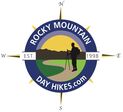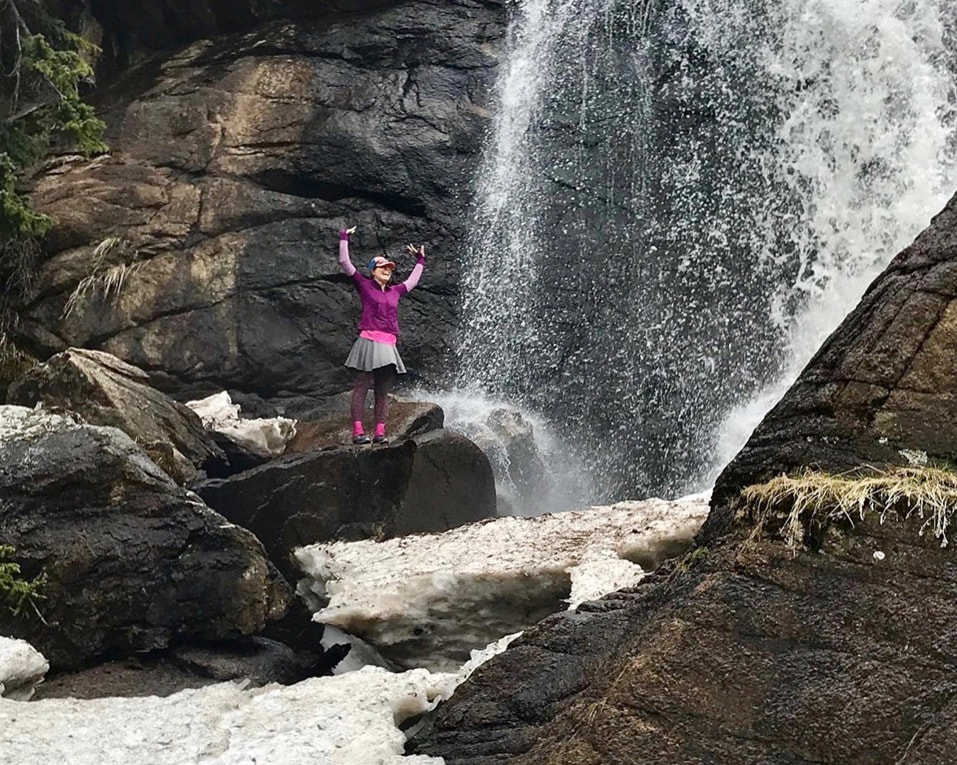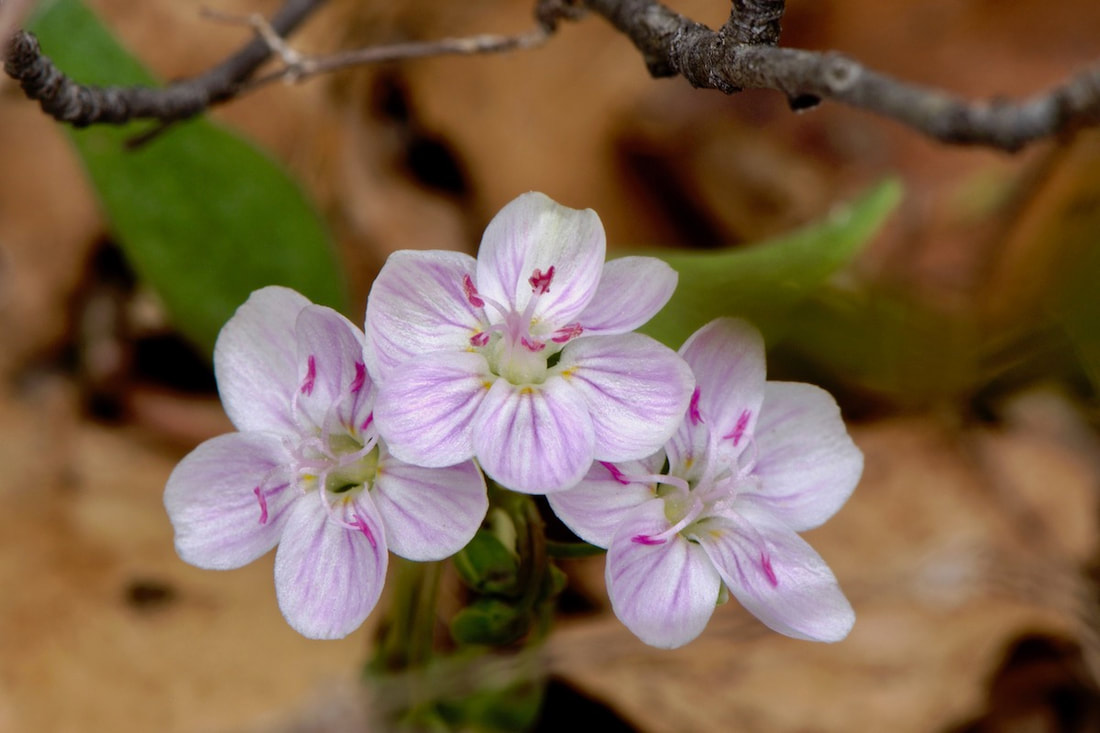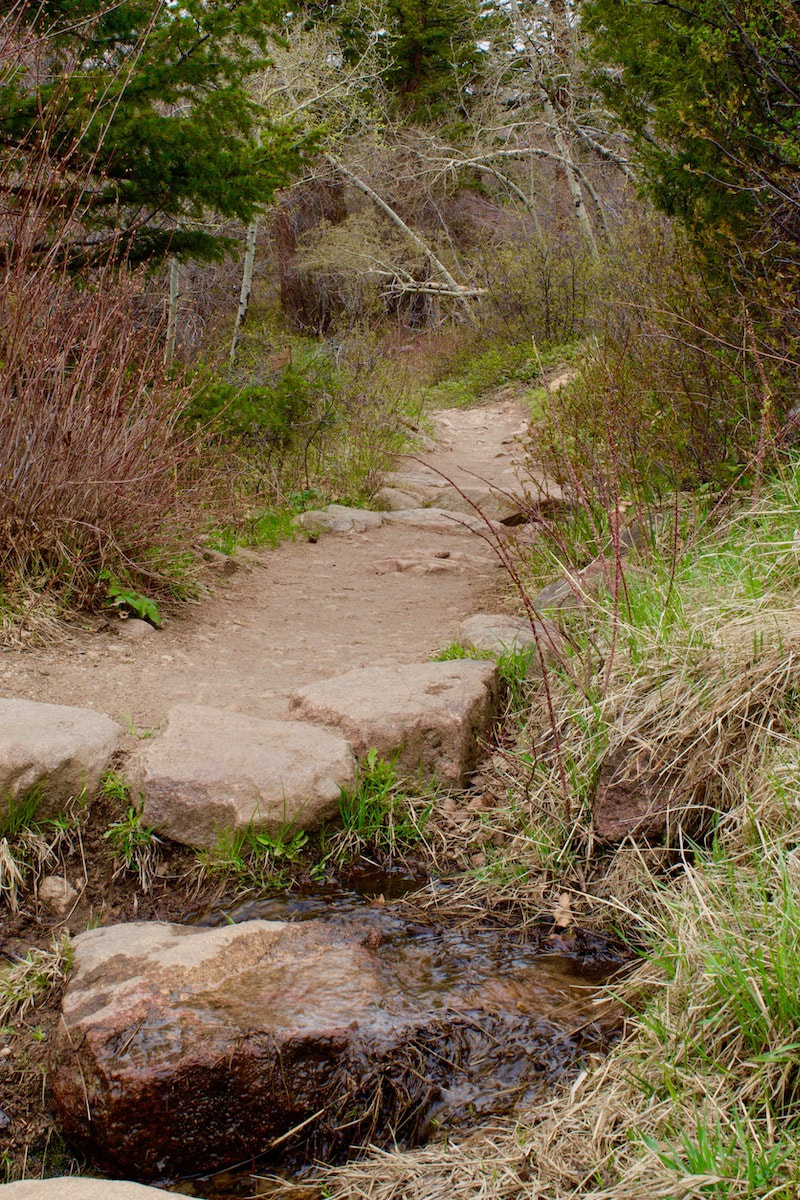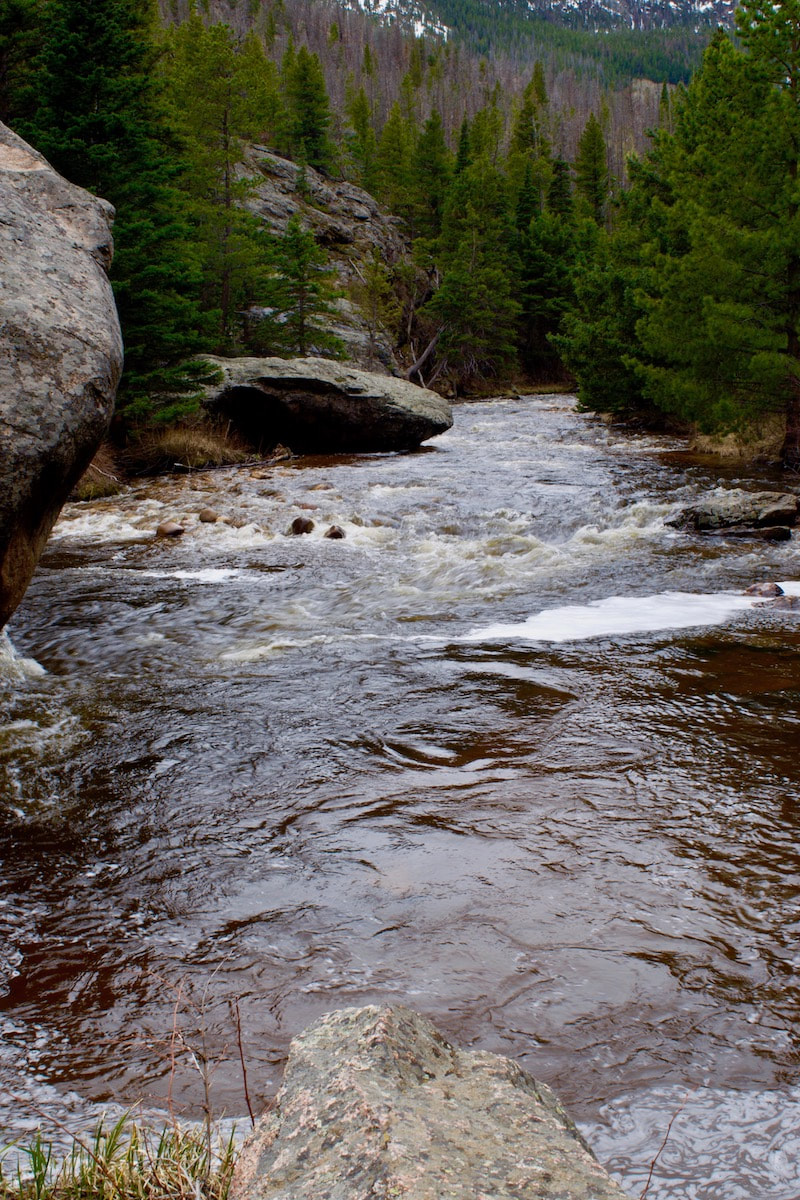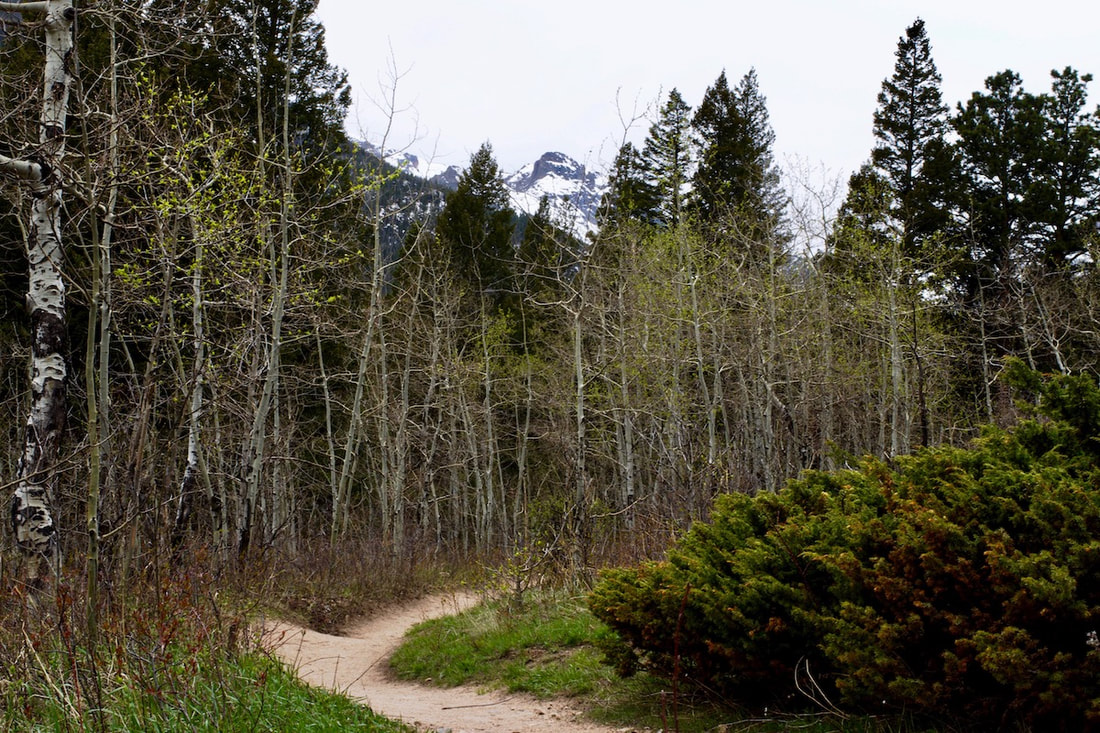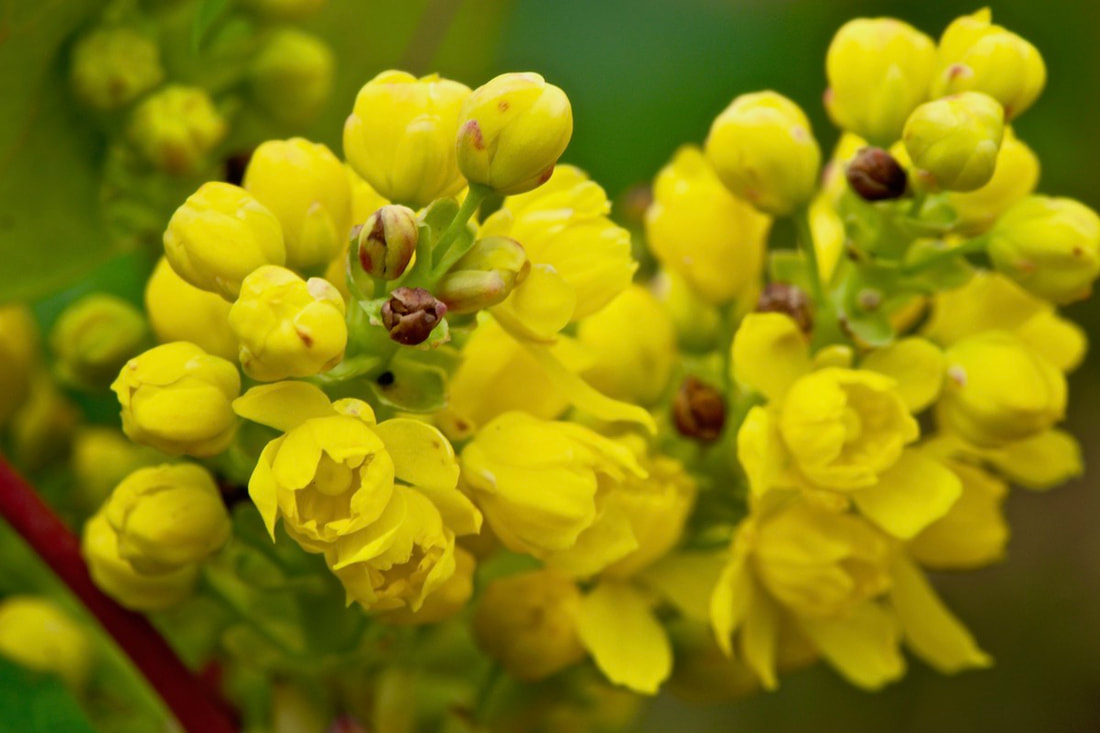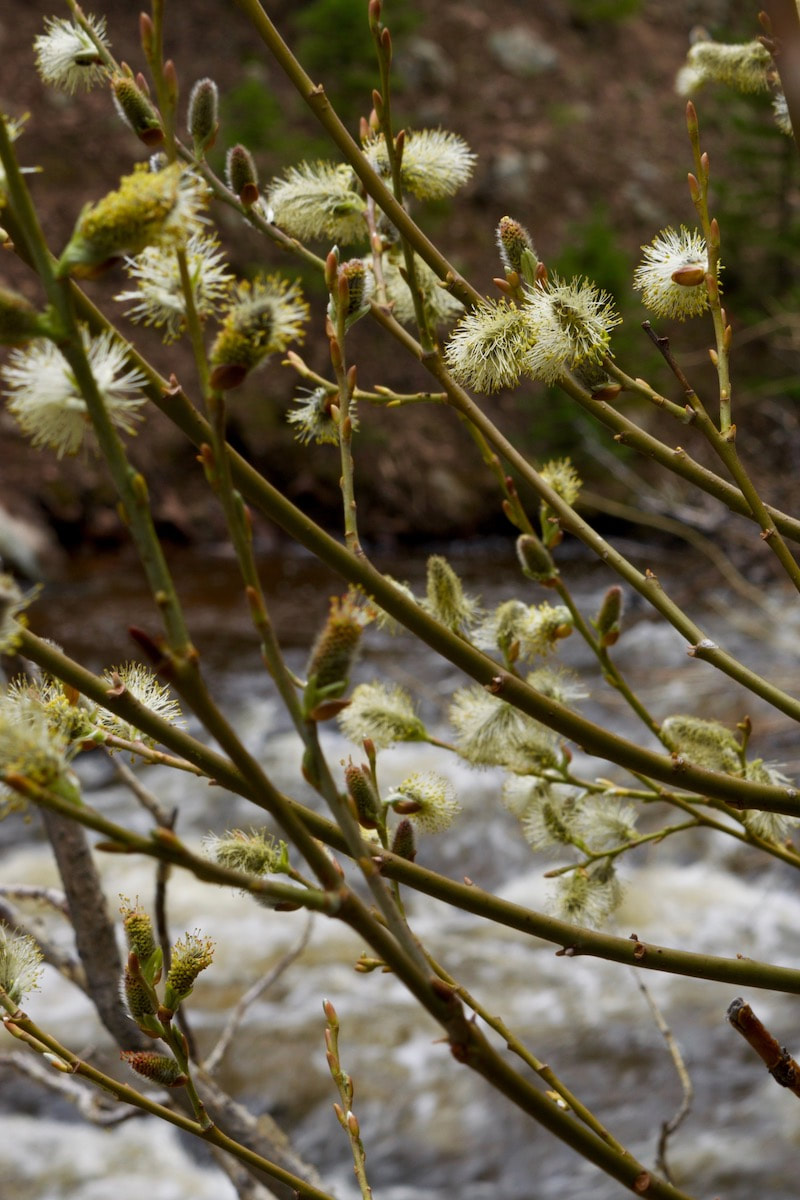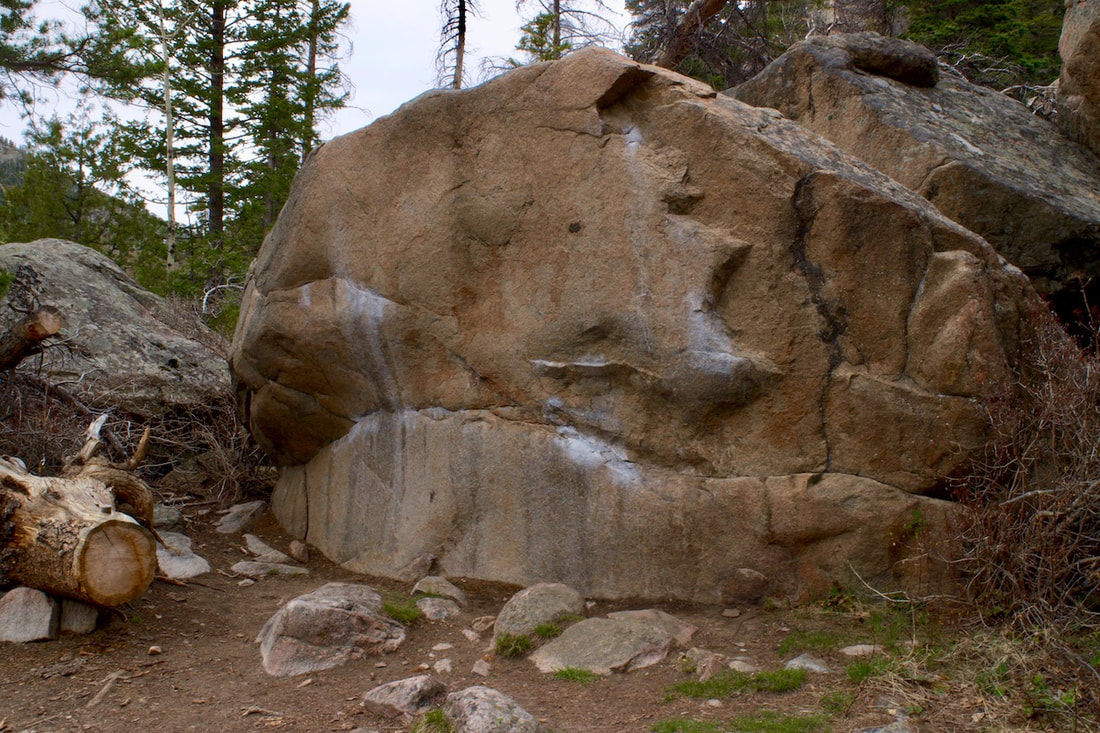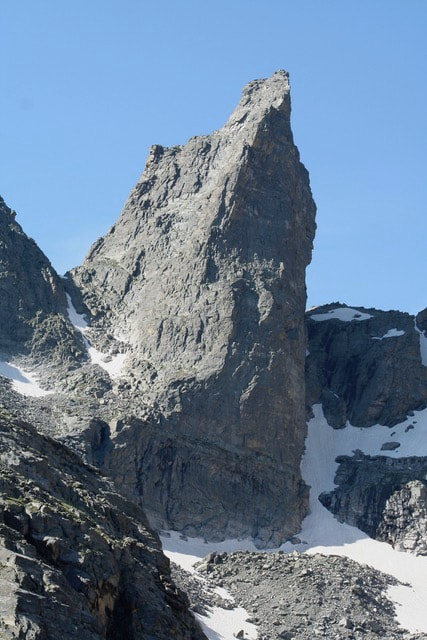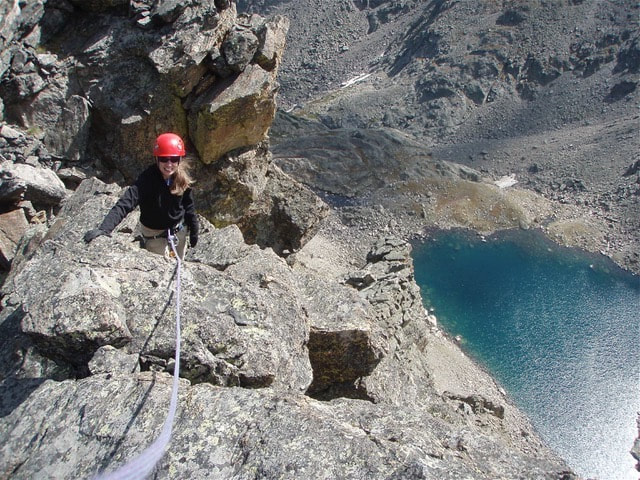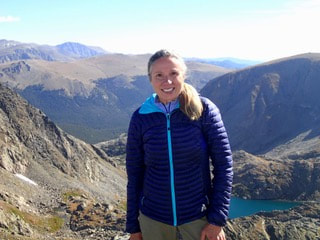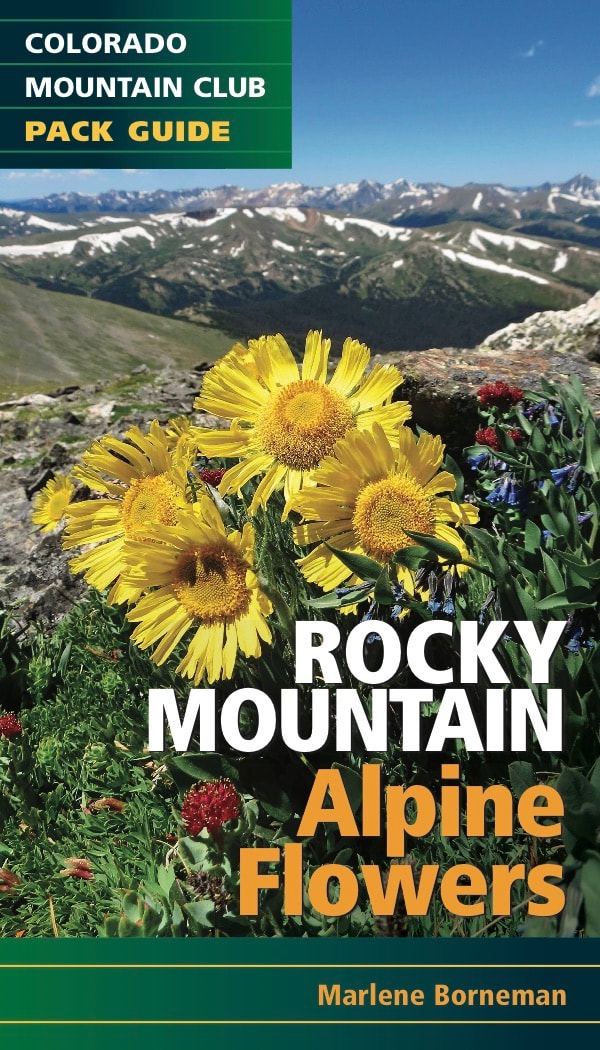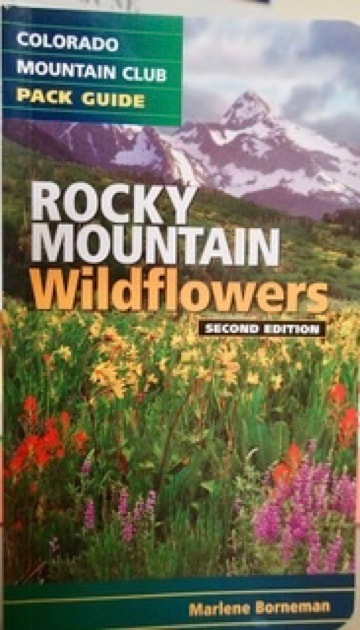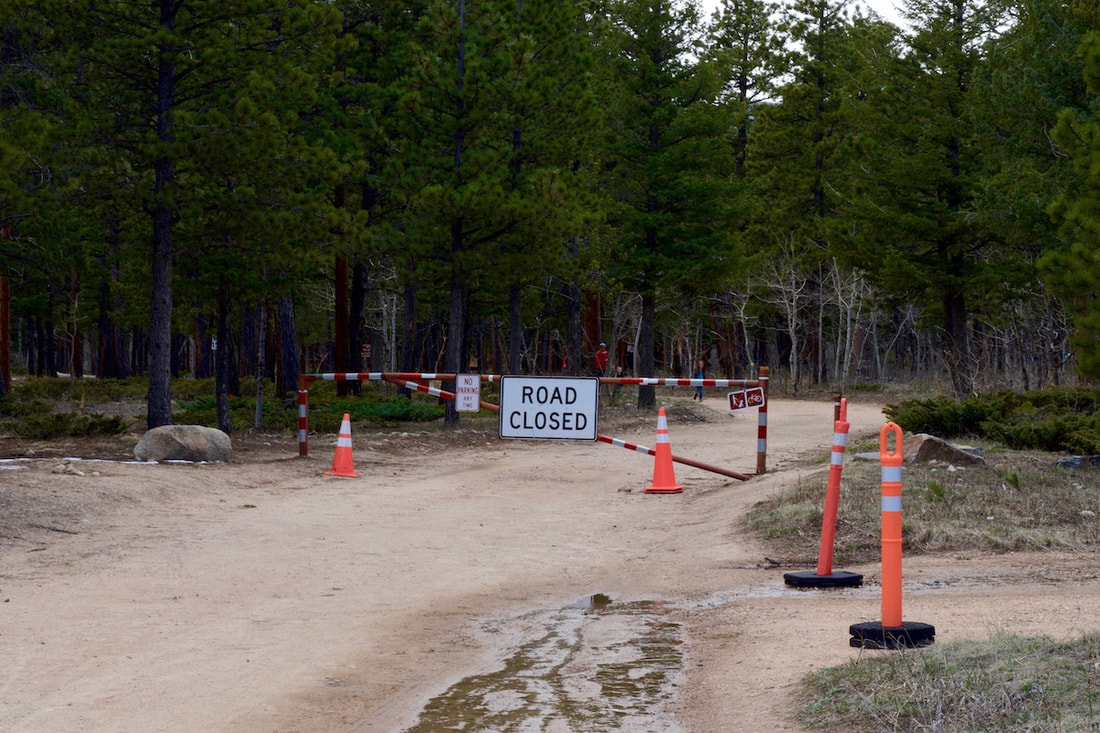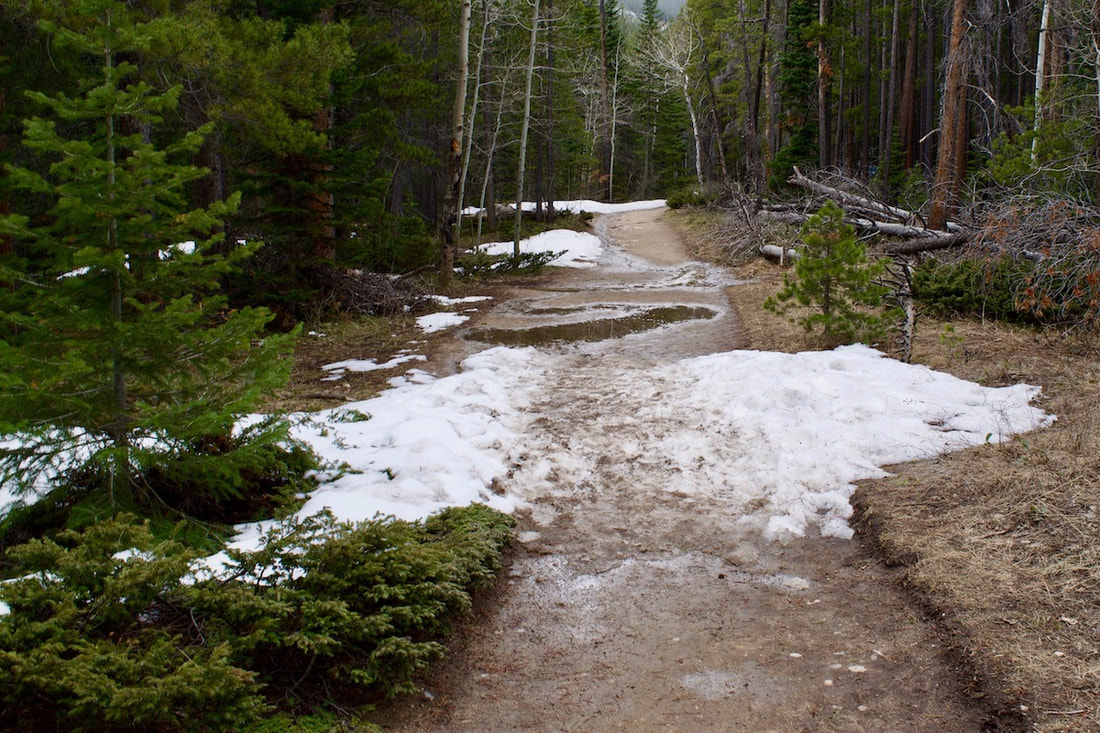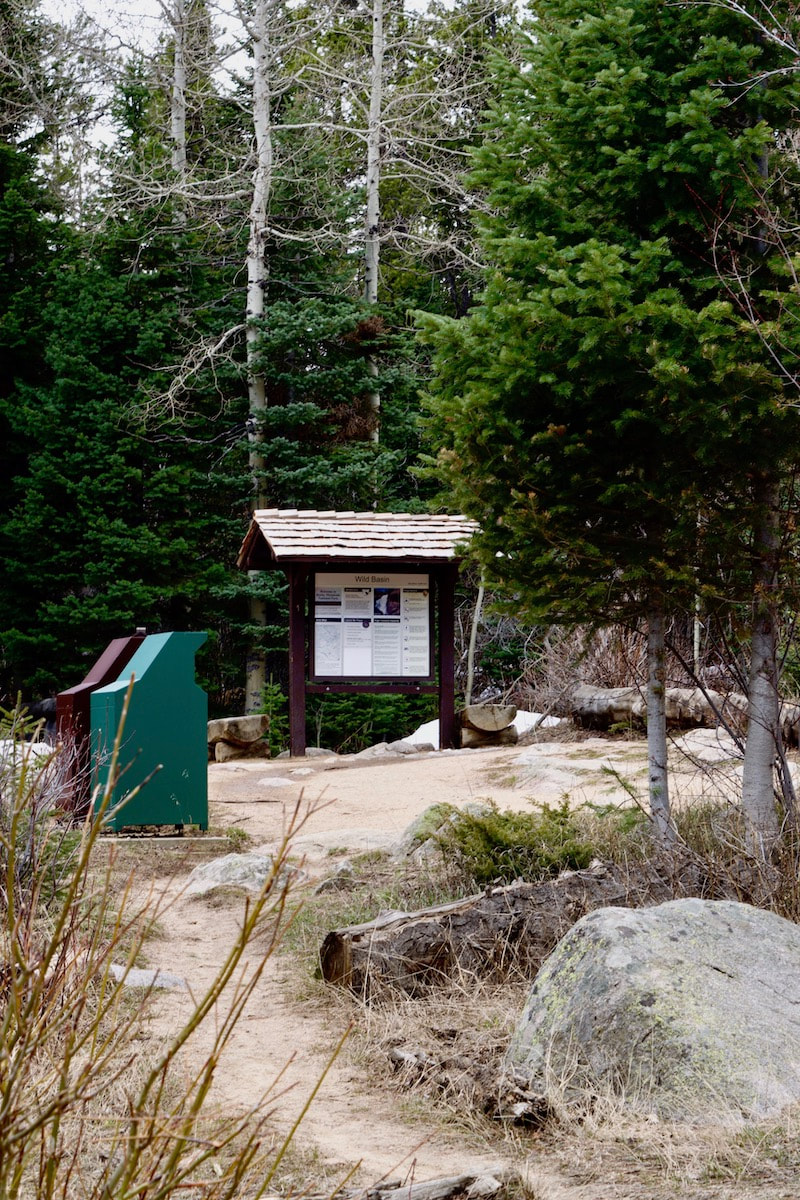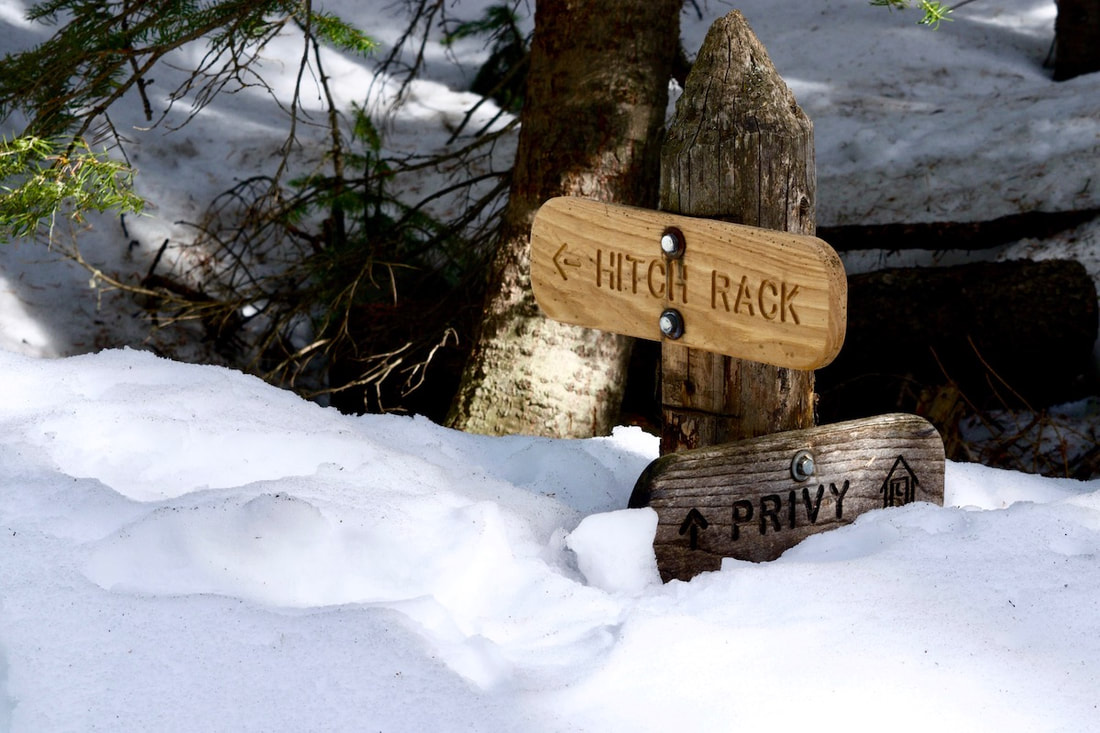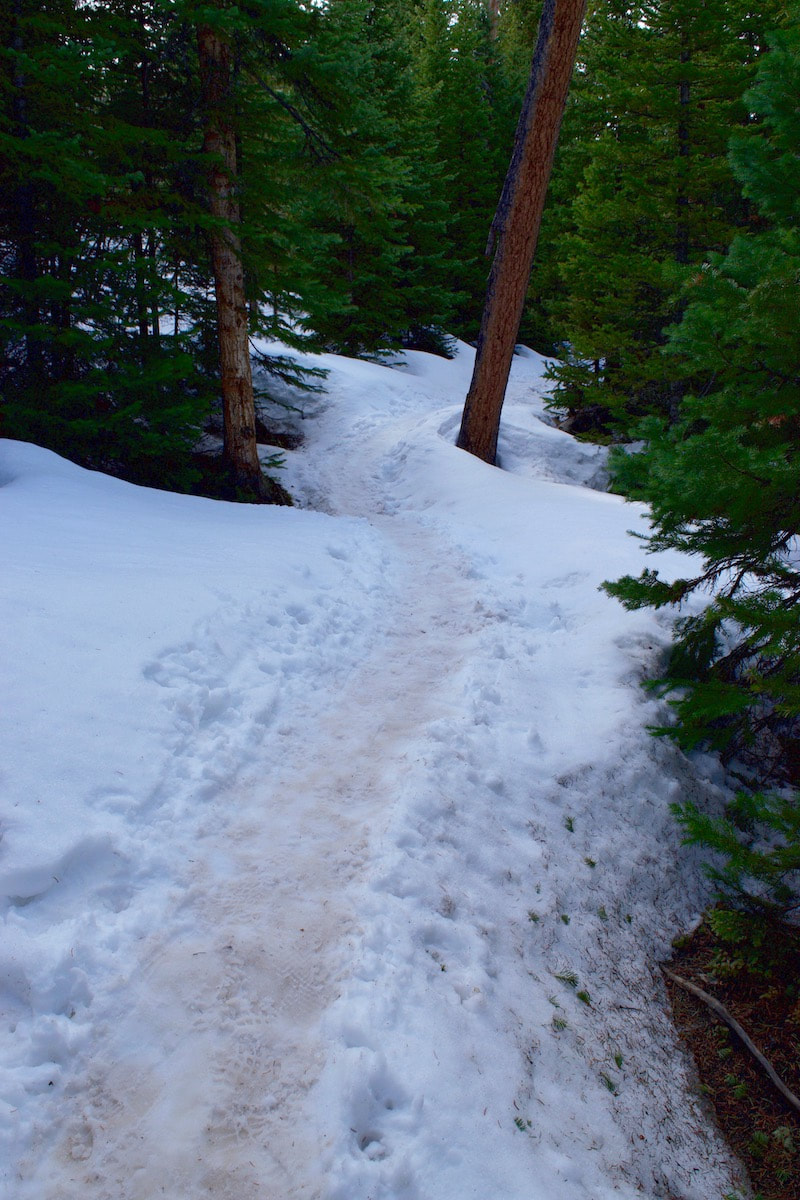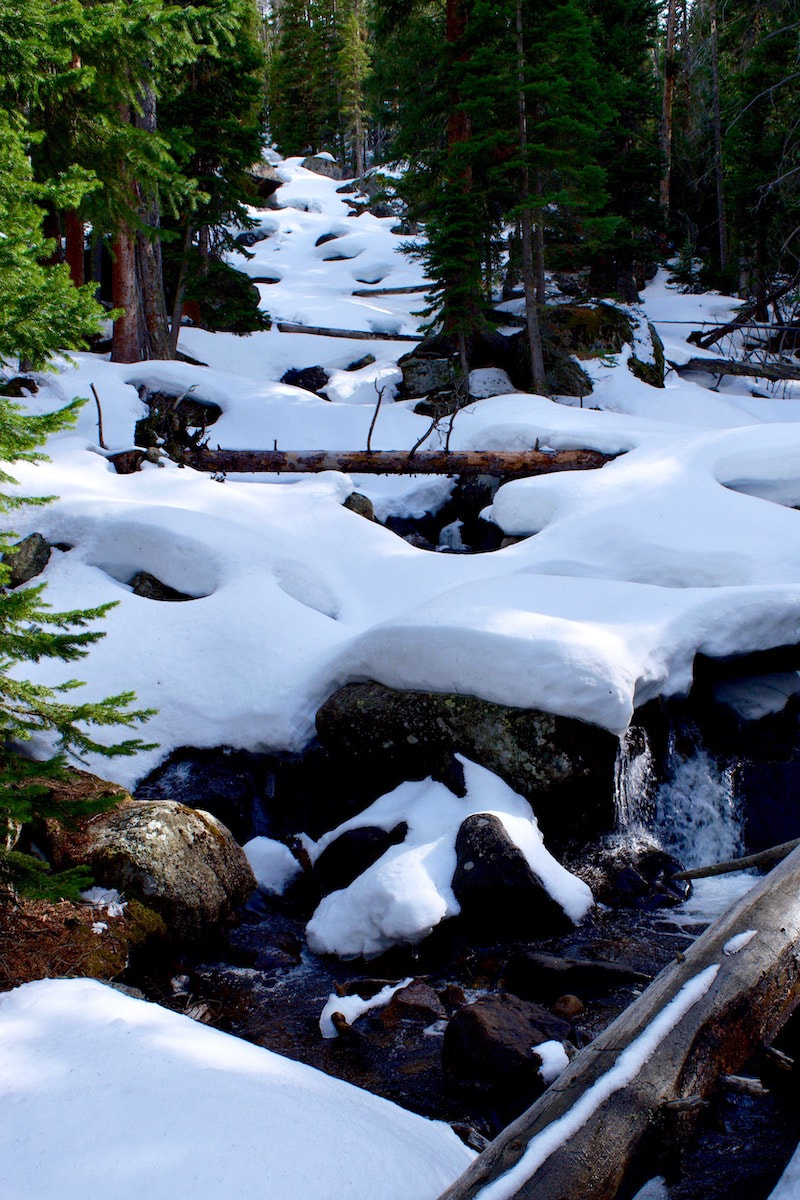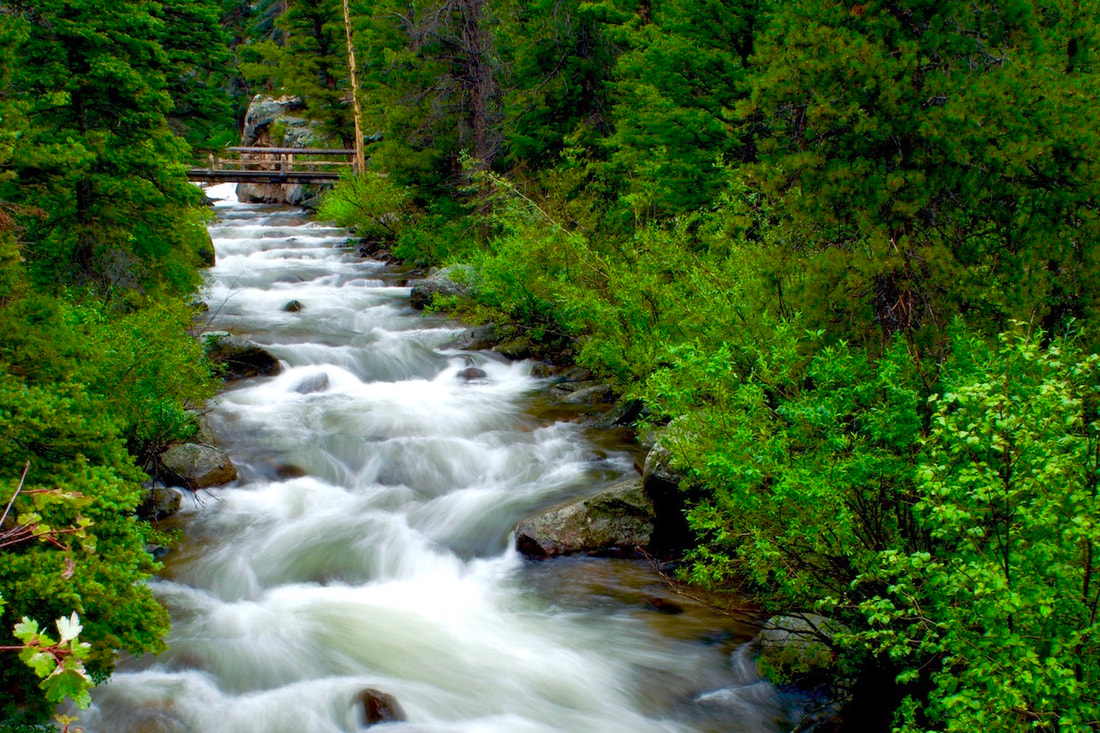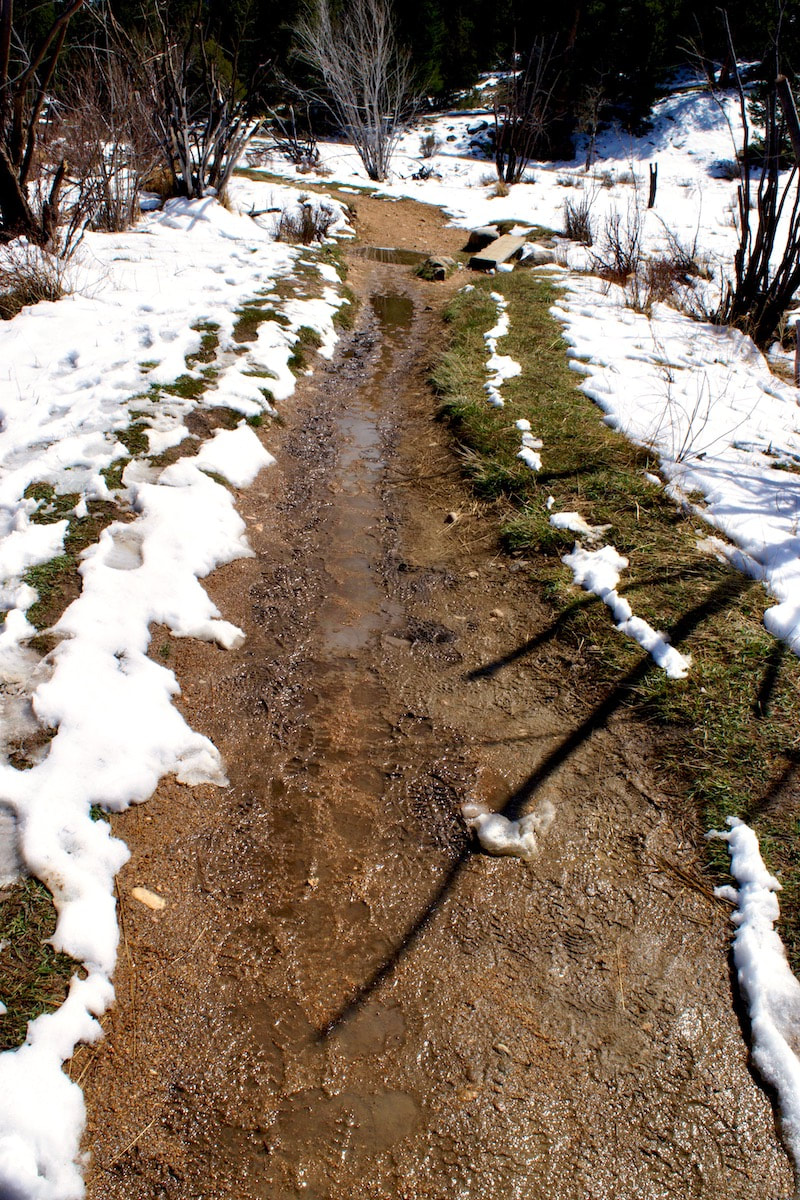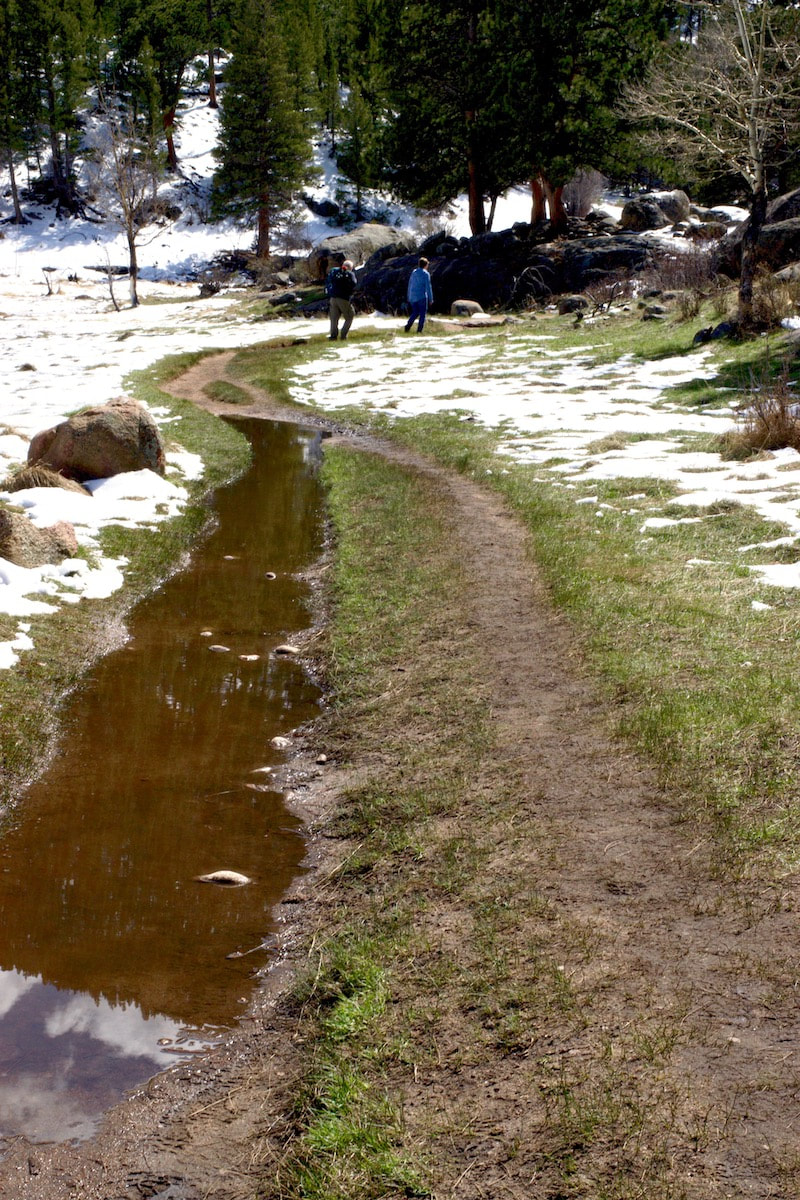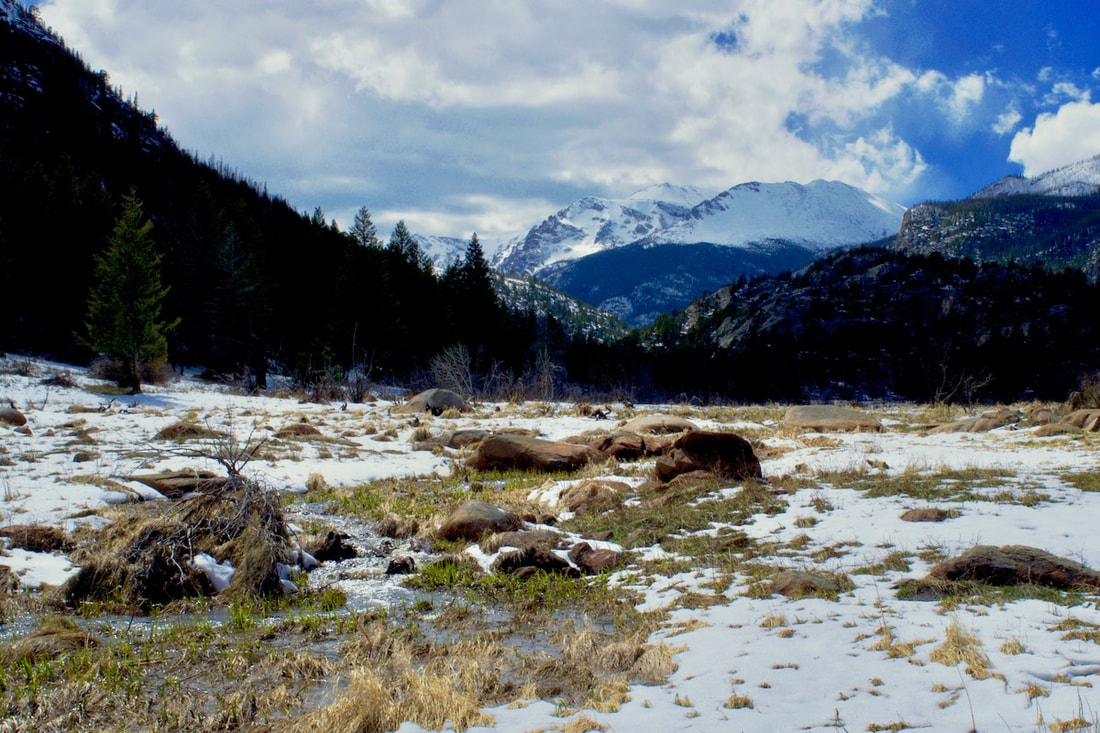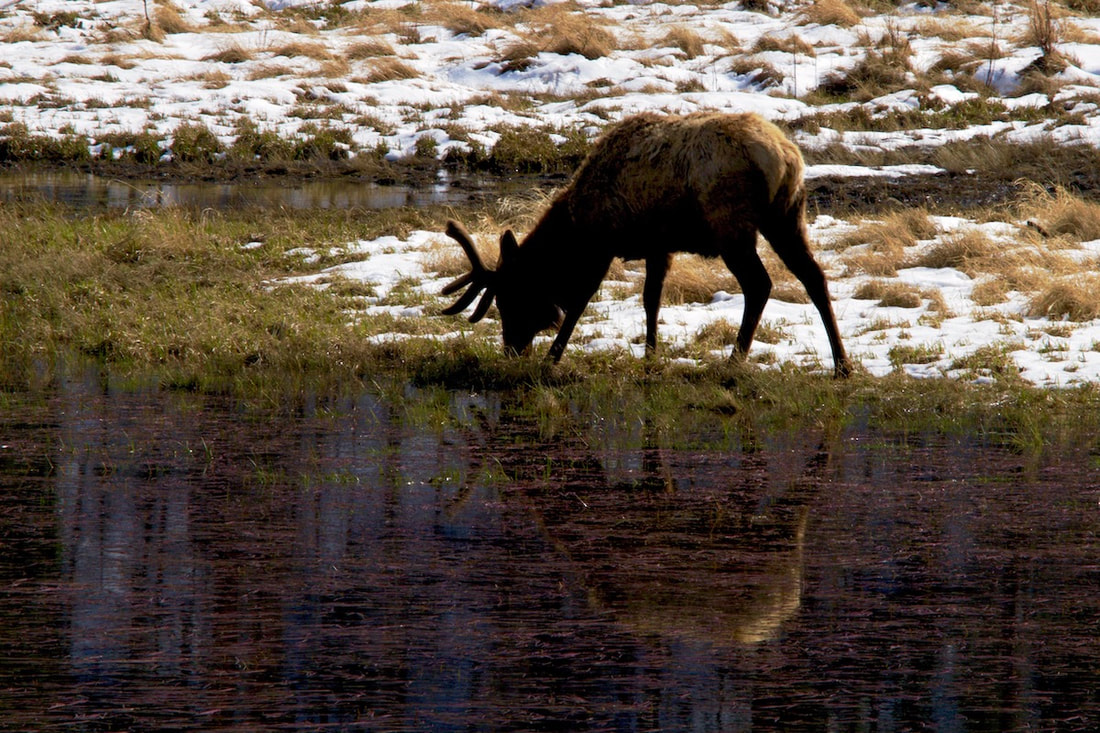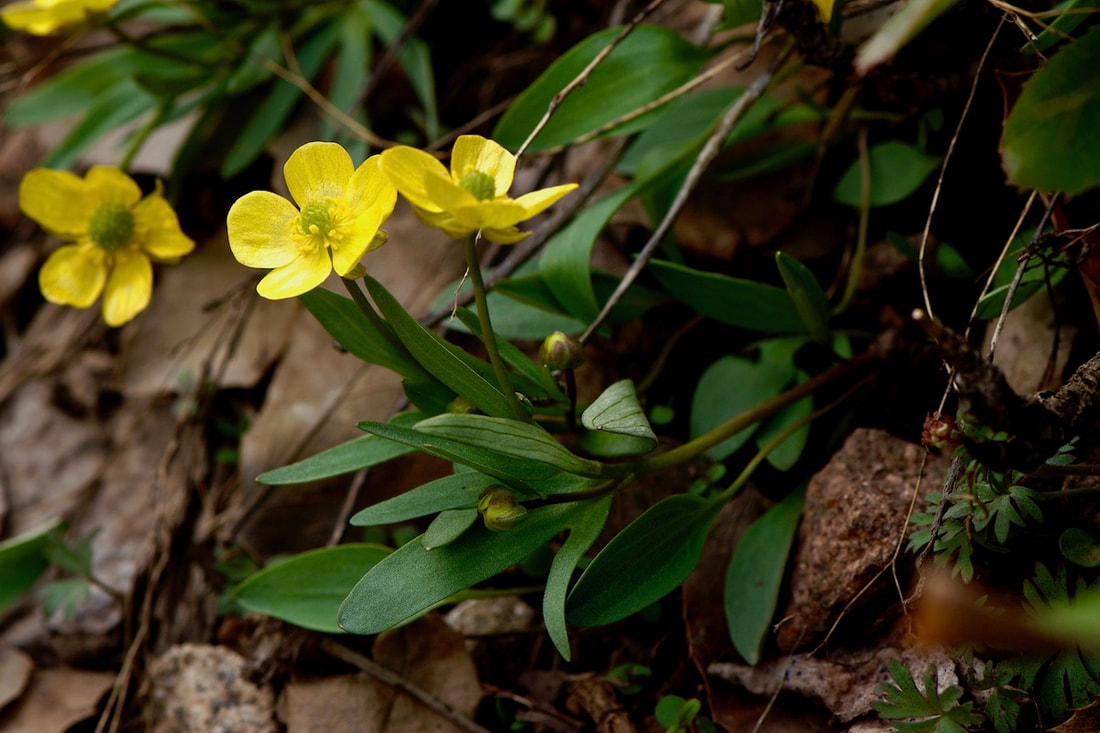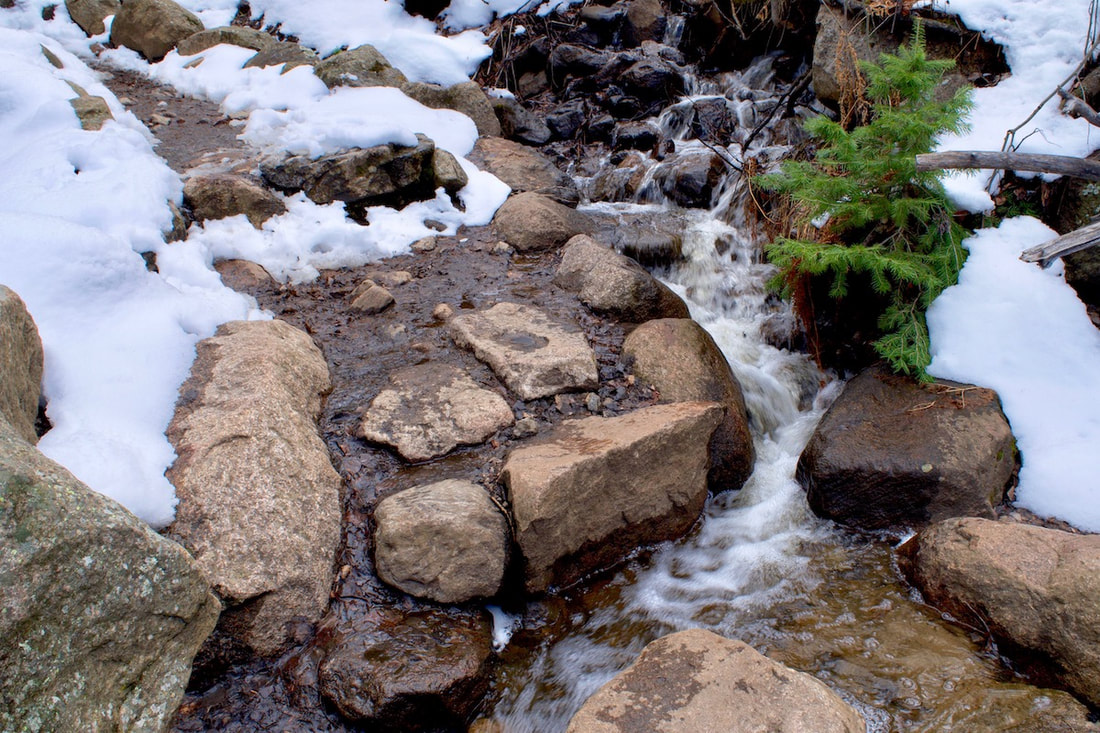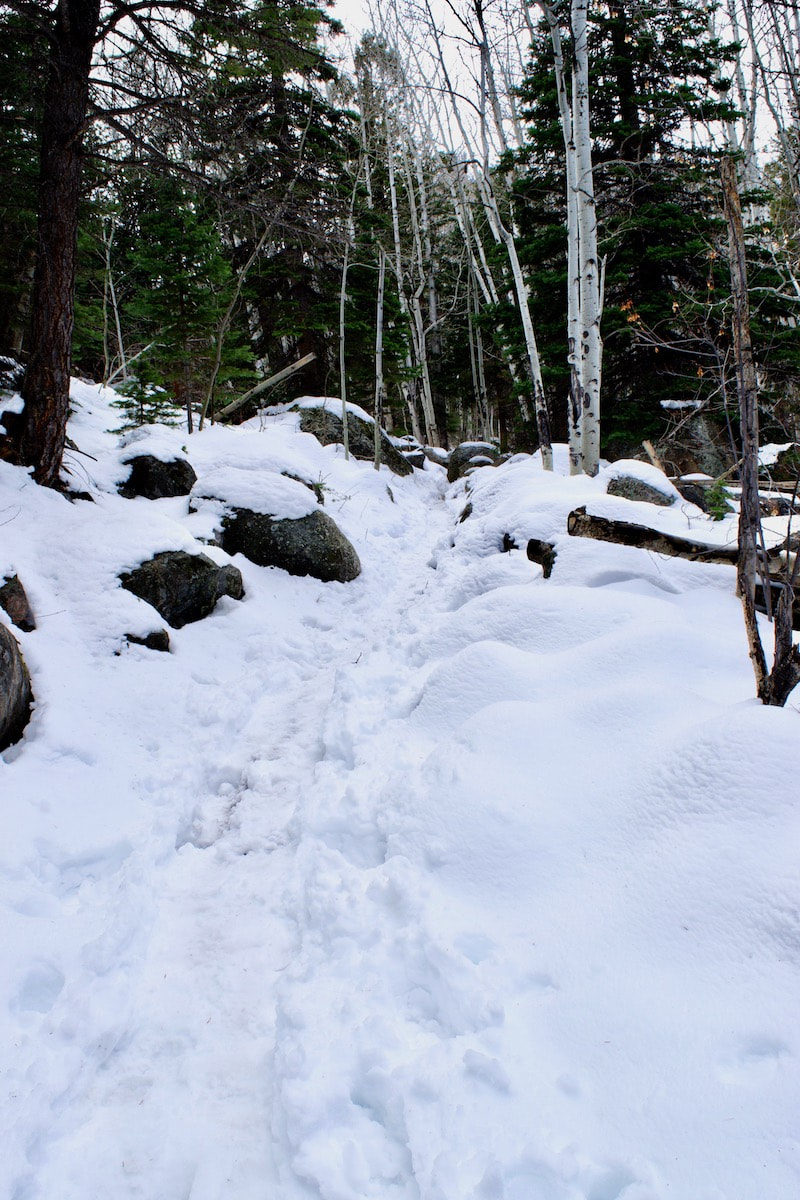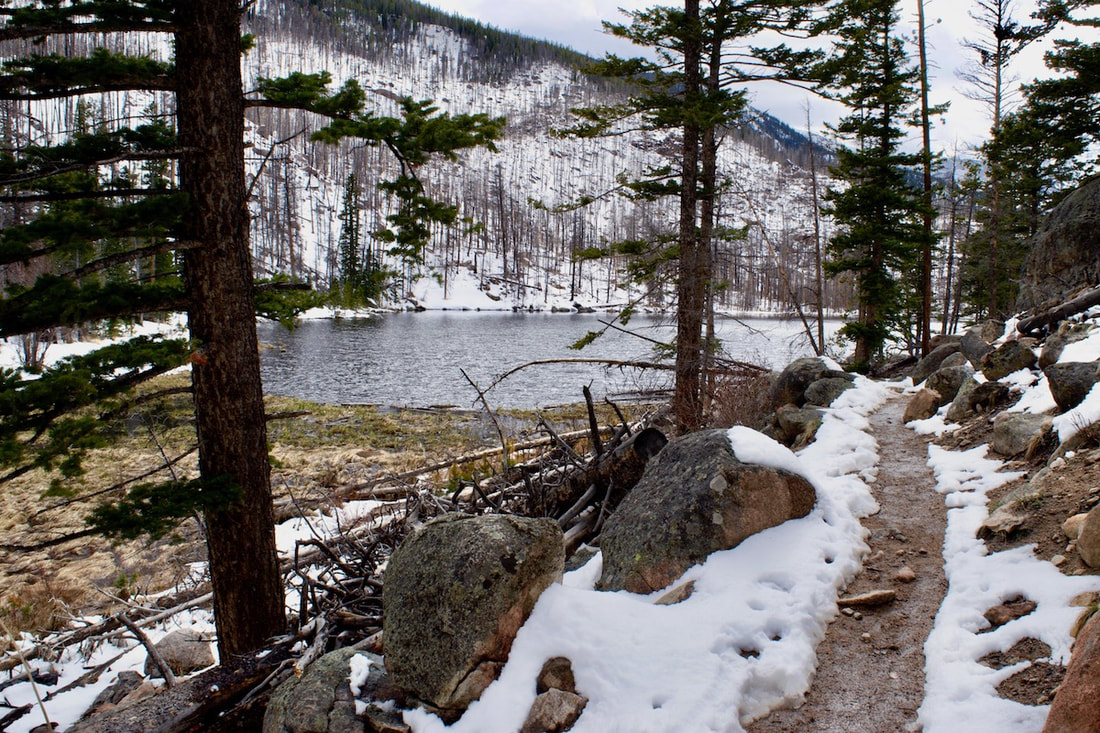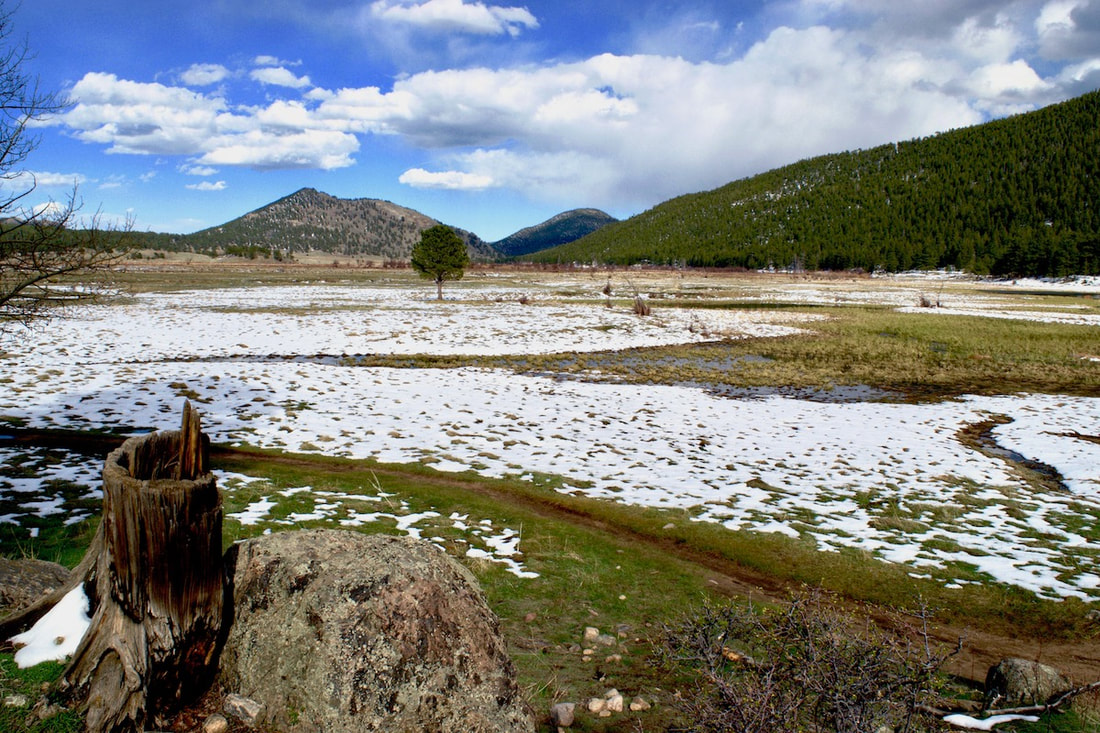|
Notes from the
Trail |
|
While I am always excited to see a place for the first time, attain a new summit or fish in a lake I’ve never visited, spring is the time of year to find comfort in the familiar; to return to the trails we’ve hiked dozens, if not hundreds of times. What a gift it is to revisit a favorite tree or boulder, to note the ever-melting snow drifts and enjoy the spring wildflowers as they begin to bloom seemingly one species at a time.
After the flood of 2013, the NPS put in a beautiful new bridge below the falls to replace the one that was washed away. I see a lot of folks admiring Ouzel Falls from this vantage point. It’s a lovely view, but an extra couple of minutes of rock-hopping and ducking under tree limbs will take you right up to the base of the falls. Regardless of what else may be going on in my life, any day I get to feel the spray of a waterfall is a pretty good day. Once the snow melts out, hikers can continue on an unmarked trail up to the big beautiful valley through which Ouzel Creek meanders before plummeting 40 feet and joining the North Saint Vrain Creek. This valley, which lies within the scar of the Ouzel Burn of 1978, is a lovely place to spend an afternoon fly fishing for small brook trout or simply enjoying the sounds of the gurgling creek while Ouzel Peak towers above you in the distance. Like me, the young aspens and fireweed in this area got their start on this beautiful planet during the summer of 1979. Nature presents us with many silent metaphors. The juxtaposition of charred trees and wildflowers reminds us that what appears completely void of life can be reborn. Calypso Orchids alongside a trail carpeted in last year’s dead aspen leaves give hope that that which appears to be completely void of life may be just moments from blooming. May we embrace this season of renewal and awakening with gratitude for the quiet lessons from Mother Earth. This is the season to return to return to the places that have greeted us year after year. Spring is a wonderful time to rediscover the lower elevation hikes in RMNP while reflecting on the past year and looking forward to the one that lies ahead. In addition to Ouzel Falls, my favorite spring hikes include Fern Falls, Bridal Veil Falls, West Creek Falls and MacGregor Falls. Mount Lady Washington is a lovely (although much more strenuous) springtime favorite at 13,281’. While the high peaks remain guarded by the lingering snow, I choose to embrace the springtime and its gifts, knowing that the season to stand atop summit after summit is just around the corner. “Hope is not born on mountain tops, but in valleys when you’re looking to the heights and peaks that you’ve yet to climb.”
0 Comments
It's time for Ask Dr. Day Hikes: Dear RMDH, Hi! Do you know if flowers are starting to bloom along the Fern Lake Trail? ML KD Thanks for the question ML KD! The trail is definitely hike ready to The Pool and up to Fern Falls. Flowers are just starting to bloom along the lower section of the Fern Lake trail. I saw a few patches of Alpine Spring Beauties and the yellow Hollygrape mostly (and dandelions). And the aspens are starting to leaf out. As I drove into Moraine Park, I could see that the upper Big Thompson River had swelled to the top of the river banks from spring runoff, but has yet to flood the meadow. I also noticed that the parking at the Cub Lake trailhead was full at mid-day. mid-week in mid-May. The road to the Fern Lake trailhead was open and the parking lot there was full as well. As the photos below show, the trail to The Pool was snow free and dry, though not entirely runoff free. There were only a few snow patches of snow approaching Fern Falls and the Falls only had snow along the edges. I did not hike to Fern Lake but hikers coming sown said there was still a packed snow trail to the Lake and about knee deep snow if you stepped off the snow trail. Here is my introduction to Rocky Mountain National Park, Colorado’s Crown Jewel. Spending time in Rocky has brought to me not only the world of climbing but the world of wildflowers. I have immensely enjoyed learning and expanding my knowledge of Rocky Mountain Wildflowers and had the honor of the Colorado Mountain Club to publish three pack guides I authored. The Alpine Flowers pack guide will be available in March, 2019. You never know how spending time in Rocky Mountain National Park will change your life forever! MY BEGINNING OF THE FINAL THREE It began innocently enough in 1974. That is when I came to Colorado for a summer job at the YMCA of The Rockies in Estes Park. I arrived from New Orleans, yes below sea level, in mid-May that year. Being a proper southern young lady I wanted to make a good impression on my new employer. I had worn a sleeveless silk dress, rather short as I recall, stockings and the cutest little heeled sandals you ever laid eyes on. It was approximately 30 degrees and spitting snow. I must tell you, my arrival ended up to be one of the scariest days of my young life. I recall saying to myself, “I have made a terrible mistake!”
From a short silk dress to summits, my progression came fast. By the end of that summer I had climbed most of the major peaks in Rocky Mountain National Park. Having graduated from college, I decided to stay in Colorado. You might say the rest is history, but it was not that simple. I lived in Estes Park for twelve years and climbed in Rocky year-round. I found myself focused on the major peaks, different routes with a few new peaks thrown in once in awhile. Then came a career move away from Colorado and my beloved mountains. To say I began grieving would be an understatement. I made the effort to spend a lot of my summers back in Rocky with “my” familiar peaks. In 2001, I returned to live full time again in Estes Park. Dorothy may have been on to something, “There is no place like home.” After completing the 54 Fouteeners in 2005, I was hit with a pain of guilt. I imagine you all know what it’s like to ignore a friendship. This was worse; it was like neglecting your own husband. After all, Rocky Mountain National Park was now my backyard! I began to rekindle my relationship with Rocky, started studying the map with new interest and curiosity.
Then, reality struck me hard. THE FINAL THREE were The Sharkstooth, Hayden Spire (both Class 5 technical climbs) and Pilot Mountain a difficult Class 4 climb. Had I set myself up for this? Shouldn’t the last peak be easy, like Estes Cone or Twin Sisters? I hadn’t climbed anything beyond Class 4 in years. I came to the realization that THE FINAL THREE were meant to be my grand finale. I needed a challenge; I wanted a challenge! I needed to gain my confidence back on the rope; I needed a plan. It sounds like I needed a lot! The Sharkstooth was the first of my FINAL THREE. My climbing partner and I left the parking lot at 3:45a.m. I once read that eighty percent of success is just showing up, I liked my chances.
As I climbed toward the summit tears were in my eyes. This was what it was about: I hadn’t gotten here because of a list, but because I had taken on the challenge of exploring the new. For me this comes with great joy, satisfaction and fulfillment. Next was Pilot Mountain, which thinking back, I over rated the difficulty. It was a fun Class 4 climb in Wild Basin. The ridge out to the summit is awesome and the view of Falcon Lake from the summit breath-taking! The last of the FINAL THREE was Hayden Spire. I had admired this peak from afar for decades, now I was coming close to standing on the summit.
Reflecting on THE FINAL THREE, I will forever remember the air beneath my feet, the sudden flight and song of finches above my head, the sense of inner relaxation and burst of excitement at the same moment and the incredible sound of the silence around me. THE FINAL THREE was my way of remembering Dick’s 20+ year companionship on these peaks. In the mountaineering world this is a speck. But it is my speck in my world and I am grateful for the opportunity to hold it in my heart. You may ask, is there anything left of that southern girl from 1974? I like to think so. My father was a riverboat captain; he lived with patience, endurance and perseverance. I like to think I gained these traits from him. And, oh yes, I still love wearing silk dresses (a little longer now) and cute heeled sandals.
Marlene has climbed Colorado’s 54 14ers, the 126 USGS named peaks in Rocky Mountain National Park and 44 State High Points. She has been a member of the Colorado Mountain Club since 1979 and is a member of the Colorado Native Plant Society. She teaches wildflower classes for the Rocky Mountain Conservancy and provides community programs to educate and promote stewardship for Colorado’s wildflowers. Marlene holds a Masters Degree in Social Work and a Certification in Addiction Counseling. She guides in Rocky Mountain National Park and enjoys sharing the scenery as well as her knowledge of the plant life and habitats the park has to offer. She is the author of Rocky Mountain Wildflowers 2Ed. and The Best Front Range Wildflower Hikes, and Rocky Mountain Alpine Flowers, published by CMC Press.
There's good hiking snow free at Wild Basin for a few miles, but only because the road to the Wild Basin trailhead is closed a mile before. That didn't stop an overflow parking lot of people from getting out on Sunday, people are anxious to get hiking. And the trail is mostly snow free and not terribly muddy up to Lower Copeland Falls. After that, it's a mix but drying out, up to the bridge over the North St. Vrain River. The river if also snow free up to that point, but only starting to swell with spring runoff. However, the final uphill stretch after the bridge quickly becomes snow covered, and it's slick going from there on. The lower portion of the Deer Mtn trail is in great shape. But once in the trees, there was plenty of snow coverage, and it was slick. The legs are tense all the way up and down trying to stay upright. Once on the flat top portion, before the final summit push, the snowshoer from the last snow couldn't find the trail. So there are all kinds of people following the wanderings of this semi lost snowshoer, and as the the snow melts, people are walking over vegetation and postholing at fallen logs. But the wayward snow trail does eventually make it's way to the summit. Subscribe to Note from the Trail rockymountaindayhikes.com/deer-mountain-31.html
The Cub Lake trail starts as one of the lower elevation trails and a good one to hike early in the season. The trail yesterday was not really ready for hiking just yet. There were a few hike ready dry spots, but most of the trail was filled with spring run off and it was a trick navigating and rock hopping to stay out of the wet spots. Please be sure to click on an image to see it larger. |
"The wild requires that we learn the terrain, nod to all the plants and animals and birds, ford the streams and cross the ridges, and tell a good story when we get back home." ~ Gary Snyder
Categories
All
“Hiking -I don’t like either the word or the thing. People ought to saunter in the mountains - not hike! Do you know the origin of the word ‘saunter?’ It’s a beautiful word. Away back in the Middle Ages people used to go on pilgrimages to the Holy Land, and when people in the villages through which they passed asked where they were going, they would reply, A la sainte terre,’ ‘To the Holy Land.’ And so they became known as sainte-terre-ers or saunterers. Now these mountains are our Holy Land, and we ought to saunter through them reverently, not ‘hike’ through them.” ~ John Muir |
© Copyright 2025 Barefoot Publications, All Rights Reserved
